If you’re not already immersed in Content Marketing, you’re probably not serious about marketing—especially online. Or worse, you’re still pretending that marketing is an expensive one-time event that’s distracting your business from its real work.
For those still in denial, Content Marketing is the new normal. And if you’re up to your eyeballs with all of the resource, technology, and process challenges that this discipline brings, what matters most is what Content Marketing actually delivers to your business. So how do you actually measure Content Marketing success?
Time to measure Content Marketing success
Any content marketer knows that you have to continuously evaluate everything that you do. The reasons are many including:
- | Insight + understanding into what works
- | Why it works
- | How to make it better next time
And because Content Marketing is never finished, there’s always the next time.
If you’ve been consistent at Content Marketing for over a year, there’s no better time to evaluate your progress than with a solid 12 months worth of data. Even better, with a structured look in the rearview mirror, you can put a clear baseline in place to measure your progress against a future point in time.
The goal of this analysis, of course, is to gain an understanding of how to to get the metrics moving up and to the right.
Where to start
A great place to start to measure Content Marketing and build a performance base line is by answering these 3 key questions:

WHAT DID YOU WANT TO ACCOMPLISH WITH CONTENT MARKETING?
CMI, Marketo and other credible sources have reported that more than half of all content marketers don’t have a written or documented content strategy.
While that may be surprising, it’s also the equivalent of starting an expensive journey without a destination, purpose or endpoint in mind. If you don’t have a content strategy, get on getting one and start here.
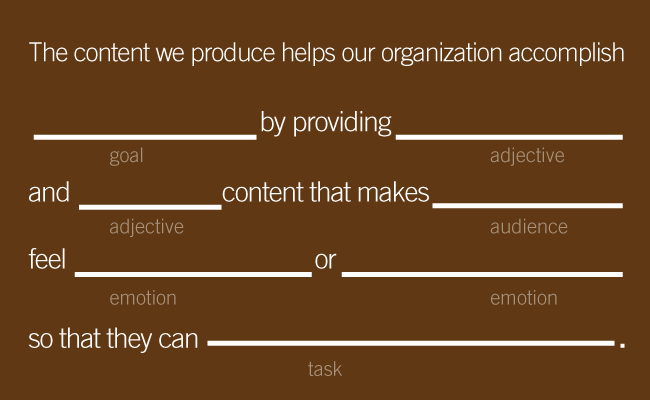
Web guru Andy Crestodina does a great job in his book, CONTENT CHEMISTRY, outlining how to develop a content strategy. He and content marketing consultant and author, Barry Feldman, also breakdown the essential components of a content strategy in this engaging podcast.
They share the need to define and document what you’ll be publishing, who it’s for and why they’ll care in an all-important content mission statement. The result focuses on making your content marketing valuable and effective for the targets you want to influence and convert.
If you’ve avoided this essential task, it’s time to face reality. You need a content strategy to keep you and everyone else on the same page and moving in the right direction—period.
 “You have to answer what will you be publishing, who is it for and why they should care?” | Andy Crestodina
“You have to answer what will you be publishing, who is it for and why they should care?” | Andy Crestodina 
WHO ARE YOU SEEKING TO ENGAGE WITH AND WHY?
Target audience, prospective customer, buyer persona. Call them what you choose but you better get clear on who it is that you want to consider and ultimately buy your solution.
That means drilling down into more than a demographic profile. Title, income, education, skill sets, organization type, industry, preferences, likes/dislikes, habits, and geography are all important. But leave out behavioral attributes and detailed characteristics that help pinpoint your understanding of their needs, challenges, situation, conditions, or aspirations and your personas will end up incomplete. Or worse, they’ll be ineffective.
The idea is to detail the individual attributes and the important triggers that can influence your target to engage with and act on your content. Don’t be afraid to have more than one persona. Just make each one as complete as possible.
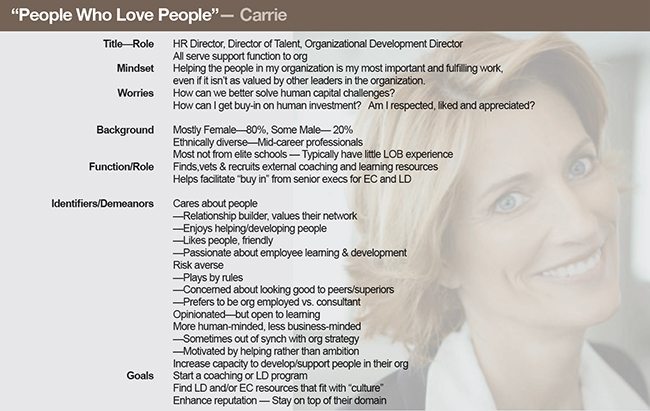

IS YOUR CONTENT MARKETING ALIGNED WITH SALES?
An essential component of an effective analysis is understanding and clearly documenting your sales cycle and what specific steps are required to take a suspect (someone you think would be a good prospect for your solution) and move them through a set of defined stages that turn them into a paying customer. That’s the point, right?
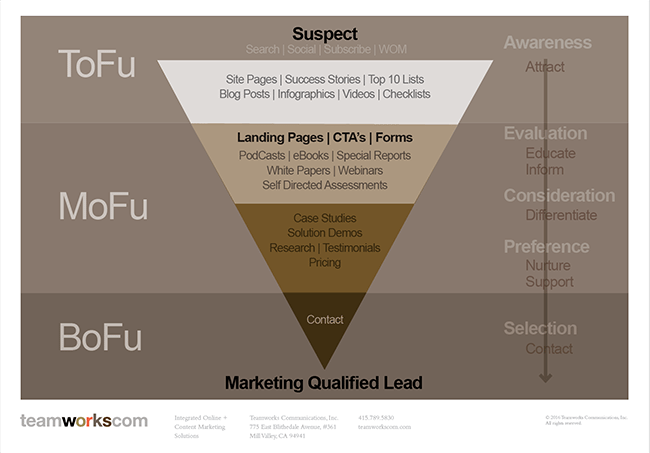
Even if you’ve been attempting content marketing ad hoc, you’ve should be able to identify a few reference examples of how someone came to your solution, became educated about it, evaluated it, and placed it on a shortlist to be considered for purchase.
In today’s sales parlance, this would be considered a “qualified lead”. Think of this prospect as someone who would be open to engaging in a conversation about your solution—and who, over time, you could ultimately convert into a paying customer.
 “Set goals jointly with your clients. That way, you’re in alignment and no one’s surprised. And make sure the goals are realistic, measurable and aligned with your sales cycle.” | Mary Planding
“Set goals jointly with your clients. That way, you’re in alignment and no one’s surprised. And make sure the goals are realistic, measurable and aligned with your sales cycle.” | Mary PlandingBuild a content marketing performance baseline with KPI’s.
To break down your content marketing results, you need to lean on Key Performance Indicators (KPI’s). KPI’s are essentially the numeric results of your content marketing effort. They provide the data foundation of performance.
What should your KPI’s be answering? This list below is a good summary and the data should come from a few credible sources including:
- | Inbound + Marketing Automation Software
- | Google Analytics
- | CRM Software
- | Social Sharing + Analysis Tool
But be forewarned, all of these data sets will probably NOT line up in perfect harmony. As this post outlines, the reasons are many. But the most important thing to understand is that evaluating and comparing a few core data sets can help you gain a more accurate picture of performance.
Follow the numbers to measure Content Marketing success.
By answering these key questions below with certainty, your KPI’s will validate if your content is building and supporting your business.
The best way to answer this is with the total number of impressions you have made over the course of 12 months. Obviously the bigger the better. And this number should rise over time with consistent content creation and distribution.
The other metrics below will provide additional insight to your content reach.
Key Metrics
- Traffic | total visits + unique visits
- Referral sources
- Page views
- Time-on-site
- Time-on-page
- Downloads
- Social shares
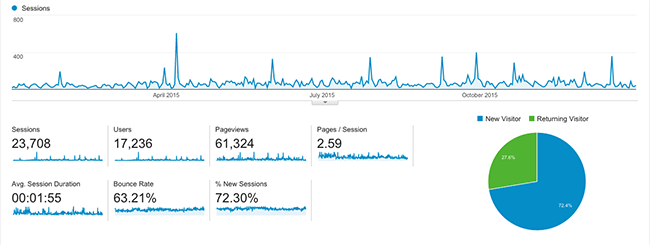
This should detail the traffic to you website and the total number of subscribers and leads that are engaging with your content. It should also provide insights on the average monthly number of site visitors and how many are converting to leads.
Key Metrics
- Subscribers
- Leads
- Site Traffic
- New Visitors

Today, just creating and publishing content is so not enough. You need to put as much effort into distributing what you’ve created so that people start to see, find and associate you with the value of what you’ve created. The so often misunderstood concept of “thought leadership” can only be accomplished if you or your business is connected at every opportunity to the value of your content.
The frequent and consistent creation and distribution of SEO optimized content can also, over time, enhance your domain authority. And in a world of millions and millions of websites, who doesn’t need that? Google puts a high value on this attribute as domains with higher authority consistently deliver better search results ranking.
Key Metrics
- Referrals
- Subscribers
- Time-on-page
- Average number of page views
- Form conversions
- PPC conversions
- Social Shares
- Comments
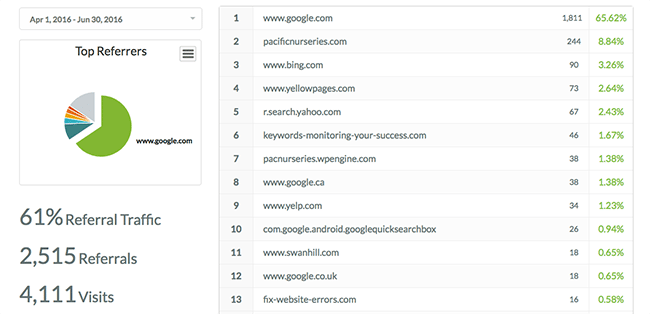
When you publish content and promote it through email and social media, recognize if there is consistent or rising interaction (clicks + conversions) with it. Well optimized pages will start to deliver long term value if you’ve applied best practices to optimize the content for semantic search.
Key Metrics
- Avg Email open rates
- Unique leads
- Avg Time-on-site
- Time-on-page
- Downloads
- Returning site visitors
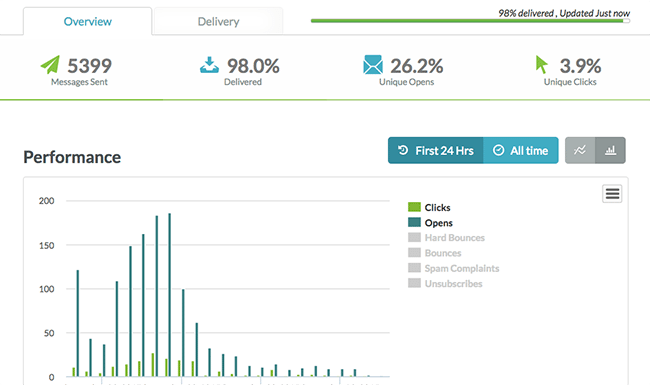
Answer this with a ranking of the most visited content on your site. Then determine if you have enabled specialized conversion opportunities—like access to a gated, hi-value asset or registration for a special event—above and beyond comments or social shares. The most visited and interacted with pages or posts should provide insight on what your audience is connecting with and reacting to.
Key Metrics
- Most viewed | Pages + Posts
- Average time on page
- Form conversions
- Social Shares
- Number of comments

A few targeted keyword searches should be a good indicator if you’ve done a good job with SEO on your site. Your ranking and position on the search page can be very telling if your site content is aligned with the needs or challenges that search engine users are querying to address them.
High quality, long form content is proving to be more effective in improving search results ranking. That’s because Google is now placing high value on a searchers intent.
A well researched, inbound and outbound linked, and in-depth article or post will always deliver better search results ranking than the mountain of less than 500 word posts that fail to answer readers needs.
Key Metrics
- Keyword search term ranking
- Referrals
- Social Shares
- Comments
- Word of Mouth anecdotes
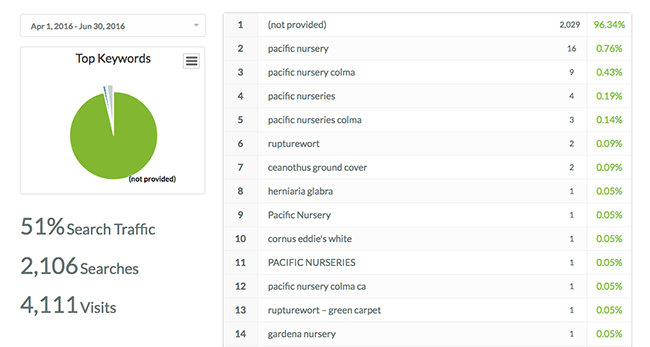
The best way to answer this is with the average amount of time a visitor spends on your site. You should also pay attention to the percentage of returning visitors and the bounce rate percentage.
This can indicate if you’re successfully bringing people back to your site because they have found content there that is helpful, informative or entertaining. If your bounce rate is through the roof, it means that those who actually do show up aren’t inspired or informed enough to stick around. This can be reflective of inadequate, unoriginal, poorly formatted content and in serious need of improvement.
Key Metrics
- Traffic | total visits + unique visits
- Bounce rate
- Average time-on-site
- Average page views
- Lead score
- Email open percentage
- Email click conversions
- Downloads + frequency
![]()
This is important to answer because it can provide insights on whether or not you’ve successfully defined your value in a way that resonates with your prospect and their needs.
This not just a home page evaluation exercise. Your USP (unique selling proposition) should be supported and enhanced with EVERY piece of content that you create.
And the voice that you use to deliver your value is as important as the message that’s expressed. Don’t get this right and you’ll succeed in blending in. Or worse, turning people away with an increasing bounce rate.
Key Metrics
- Form conversions
- Lead volume
- Social Shares
- Time-on-page

A great way to answer this is through the quality and volume of comments on your content or blog, increasing form conversion velocity, and anecdotal comments to your sale team or public facing support staff.
You need to become known for your value. You’ll know if your prospects and site visitors are able to easily understand your value because more often than not, they “play it back” to you when they interact with you or your solution.
Key Metrics
- Lead quality + score
- Comments
- Social Share volume
- Time-on-site
- Time-on-page
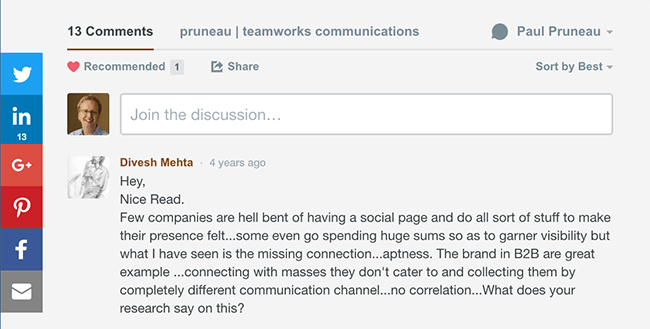
There’s no better way to measure this than by the number of conversions on your site. Here, prospects give up their contact and need information by filling out forms that enable access to gated content that meets their interests or needs.
Every time that this happens, it presents an opportunity to further a relationship by following up automatically with a form submitter by providing additional content that is aligned with the interest or needs that they shared.
Measuring and monitoring this effectively is virtually impossible without an integrated marketing automation and inbound marketing platform. Today, these powerful and expensive software platforms are essential for successful content marketing operations and analysis.
Key Metrics
- Form conversions
- Email conversions
- Subscriptions
- Downloads
- Lead score trend
- Marketing automation trigger frequency
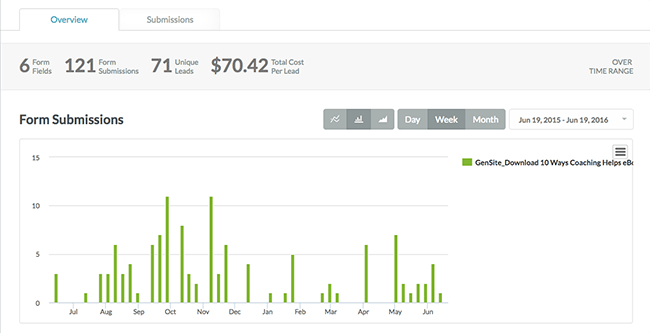
 “When you show up with relevant content for your audience and they have a need, they’ll get in touch.” | Martha Spelman
“When you show up with relevant content for your audience and they have a need, they’ll get in touch.” | Martha SpelmanAny senior business manager wants to understand if all of the online Buck Rodgers is actually turning into real bucks. The best way to answer this is with a rising volume of qualified leads. As any seasoned marketer knows, marketing does NOT close sales.
However, by laying an effective welcome mat for the salesperson, all of the effort and expense of delivering a qualified lead should enable a capable salesperson to bring the prospect over the threshold and into the most valued position in any business—a paying customer.
Key Metrics
- Qualified lead to opportunity conversions
- Increasing opportunity size + volume
- Close frequency
- Email conversion growth
- Contact form submissions
- Downloads

 “Ultimately, as marketers, our job is to generate revenue and to produce a return on investment.” | Andrew Erickson
“Ultimately, as marketers, our job is to generate revenue and to produce a return on investment.” | Andrew EricksonDrill down for a more successful path forward
All of these answers should be supported with granular detail about which content marketing tactics, specific executions, campaigns, and even emails performed best to further your goals and strategy.
For example, if a high-value asset like an infographic gets 3X the downloads of every other ebook, white paper, podcast, or other assets, it would be reasonable to assess that your audience likes to consume this type of graphics-oriented content. Take away = make more of it ASAP.
This kind of analysis should also be performed on your blog content. That means the posts that received the most view, shares or conversions are the ones that resonated with your targets because they actually acted on what you produced. Take away = do more of that stuff.
Document and share analysis results
After all of this data and introspection, it’s a good idea to summarize your findings by detailing the content marketing lessons that were learned over 12 months of effort.
Zeroing in on what was most successful will guide what to do next to improve engagement, conversions, and performance.
It will also put a stake in the ground for your next comprehensive performance analysis. And with a transparent and supportable data set, everyone knows where they’re at and what needs to be done better to improve performance.
Your turn
With all of the buzz, tools, and discussion about Content Marketing online, some might assume that it’s a DIY discipline that just about anyone can do well.
The challenge with that POV is that every part of Content Marketing is constantly moving and changing every day. As a result, the number of skills, talent, and fluency required for research, content creation, optimization, deployment, and analytics make sustained success a significant undertaking.
That’s also why it’s more important than ever to measure Content Marketing progress and results are to understand how it is delivering value to a business.
How are you faring with measuring your Content Marketing success?
Looking forward to hearing from you.
- | Quick Reference Guide for email performance.
- | What’s the difference between Marketing Automation and CRM?
- | Measuring Content Marketing: Are we on the same page?
- | What’s the best time and place to post on social media?
Ready to take your brand to the next level online?
If you’re ready for some fresh-thinking with a qualified resource to address your online marketing challenge, we should talk.
As president and creative director of TeamworksCom, Paul develops brand strategy, engineers content to express customer value and creates integrated online and content marketing solutions to help businesses succeed. Connect with Paul, send an Email, or just call 415.789.5830.
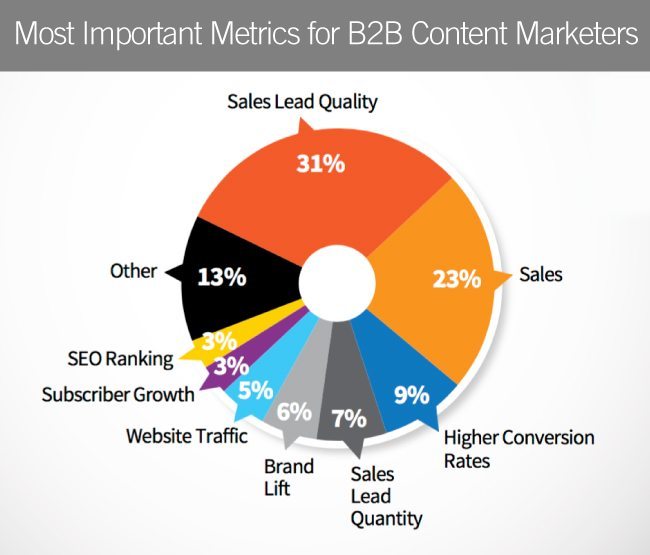

Hi, Paul. Thanks for the great article! What is your advice to marketers on how to maintain focus on results – with so many metrics to drive, measure, analyze it’s easy to lose sight of the forest through the trees.
Thanks for your comment Andrew.
You’re right. As you know, there are no shortage of metrics to analyze for content marketing success. They all matter and they’re all connected.
Yet, I think the ultimate measure that matters most to a business is the number of leads that content marketing delivers. Because leads can turn into sales opportunities and ultimately revenue.
But if sales isn’t aligned with marketing, and the qualified leads that are placed on the sales team’s door mat aren’t skillfully and consistently converted and closed, all of the effort and spend to get those leads starts to get questioned.
Hope this helps. And thanks again for your comment.
[…] ROI […]